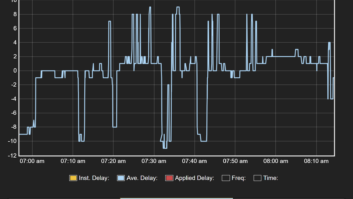We’re in an entertainment era called “Peak TV,” a term created by the head of FX John Landgraf. It refers to the large number of high-quality shows that fill the tube: “Game of Thrones,” “Veep,” “This Is Us,” “House of Cards,” “Empire,” “Walking Dead,” “Better Call Saul,” “Fargo,” “American Horror Story” and the list goes on.

But Landgraf also said, “There is simply too much television.” He told media critics that the audience “is overwhelmed by the sheer volume of TV shows,” and counted close to 500 original scripted television shows across all platforms in 2017. That’s up 75 percent in just five years.
Radio has also expanded to where there are now more than 28,000 licensed outlets sending out audio programming, including translators and low-power stations. That’s up over 30 percent in five years and almost twice the number of outlets compared to just 20 years ago. So with such a dramatic increase in radio availability and the expansion of audio programming through thousands of internet-only “stations” and podcasts, can this also be called the era of “Peak Radio?”
TOO MUCH RADIO?
During a recent vacation, I scanned terrestrial stations and SiriusXM, along with reviewing online radio. I concluded that the dramatic increase in audio options has actually led to somewhat of a decline in the quality of terrestrial radio.
It appears that as the radio business expanded during a time of tightening economics, untrained and inexperienced talent was hired and shortcuts to creativity were taken. Much of it sounds amateurish and lacks originality.
Sad to say, but there may also be just “too much radio.”
Take sports talk, which has grown so fast that hundreds of know-it-all average Joes in local markets don’t know how to do a cohesive show. They’re superfans, plucked from being good callers or operating message boards or writing for a print publication. Unable to communicate clearly, they stumble, pause, don’t do homework, grunt, miss basic formatics and go off on self-centered tangents that often are of no interest to the audience.
In music radio, ownership consolidation has led to announcers voice-tracking multiple stations or talent getting placed in formats where they don’t match the station sound. I know of one cluster where the gravelly voiced classic rock chick was moved to the newly flipped talk station, although she had no experience in verbalizing for more than a few minutes in between songs. When she failed at long-form political talk, they moved her to voice-tracking a country afternoon show — where her vocal skills seemed equally out of place.
News/talk radio has some quality national and local veterans that know how to tackle the latest topics and take callers. But after scanning the dial searching for interesting, newer talk hosts, I wonder how some got their jobs. They think talk radio is all about having a big blustery ego, when in truth it’s about the ability to deliver compelling content that engages listeners. They’ve tried to copy Rush Limbaugh’s bombast but failed to realize that Rush has attracted an audience by making political content palatable through entertainment.
Even Howard Stern (and I know some will object that anyone dare voice this opinion) just isn’t that good during large portions of his SiriusXM show. Filling four or five hours daily is no easy job, but at times Stern seems to be phoning it in, with long periods of dead air and dull material.
Yes, he does some great interviews and has moments of high entertainment; but for the highest-paid man in the business, he should be working a lot harder to provide great minute-by-minute quality content to those that pay for the right to subscribe to his show.
I tuned in one day last fall to hear Stern talk about using a plunger, laughing about “doo doo” and how he’s grossed out by toilets being backed up. Then he transitioned to how he didn’t know the Rams had returned to playing in Los Angeles over a month earlier. Potty humor, and ignorance that sounded unprepared and out of touch. Maybe two or three hours a days would make for a better Stern Show.
On the other end of the SiriusXM spectrum is “Radio Andy,” a newer channel that was handed to a guy with no radio background, Bravo TV’s Andy Cohen. The station appears to have no idea what its brand is. In one day I heard a mishmash of “Real Housewives” gossip, feminist empowerment, gay subculture, and … Bon Jovi? What is supposed to be a talk channel was playing classic rock music one afternoon with “Dead or Alive” coming out the speakers. (And Bon Jovi had his own SiriusXM channel at the time as well!)
SiriusXM mistakenly thinks that any standup comic, movie star or musician has the ability to creatively fill air time. It’s quite the opposite — we instead get Brooke Shields stumbling through her show open, repeating the same phrases over and over, telling the audience she doesn’t know what she’s doing, and then overpraising her guests, ending with telling us that she had so much more to talk to them about but ran out of time. It’s actually pretty annoying.
Terrestrial radio king Rush Limbaugh is still the role model when it comes to filling audio content and attracting listeners, but if you listen to all three hours daily (as I did all summer), you’ll find him to be incredibly repetitive and often simplistic. Some of this is intentional to put across his points, but often it feels like he hasn’t done enough homework or that he is following an outline from Donald Trump’s press office. While he claims to spend six to eight hours a day in prep, the show focuses on a narrow amount of content spread over a long period of time with the same thoughts often repeated day after day.
Rush and Howard were certainly great hosts at one point, but if they are the best we’ve got today, then the business appears to be beyond the “Peak Radio” of the late 1990s and early 2000s. Listening to Stern and Limbaugh now is a little like watching a 29th season of “Game of Thrones.”
TURNAROUND TIME
There are two solutions that I think could turn radio around and create an atmosphere of peak listening again.
First, radio has to improve its training of professionals, and it can do that by creating formal standards for those who want to get into the business. We’re a generation removed from the old FCC requirement that announcers be licensed in order to work in radio, and two generations past the difficult exam a board operator had to pass in order to just be left alone to run a station.
The NAB and higher education institutions could partner to offer some type of certificate required to work in the business. This could be done through a weekend seminar led by professionals or a class at a community college or a full-on degree at a liberal arts university.
Instead of the government licensing announcers, the industry could uphold standards by requiring everyone to know the business of radio, including celebrity talent and brokered show hosts. Legal issues, formatics, FCC rules, business aspects, voice delivery and personality coaching could be included. No more blindly putting on the air untrained a newspaper columnist or lawyer or rocker who couldn’t make it in the music business
The second part of the solution is to return to the glory days of radio and emphasize content over image. Radio needs to challenge employees to be more creative and do more with gimmicks. Too many do a quick internet search and call it “show prep” instead of spending hours in the production room creating great original content.
It used to be that radio was filled with stunts that would have people talking. But that has mostly been replaced by late night TV where Jimmy Fallon or James Cordon do something that goes viral on social media — and radio hosts the next morning end up talking about what the TV guys had done the night before!
We need more entertaining audio gimmicks, like Glenn Beck’s “moron trivia,” where they would blindly call ignorant convenience store workers and ask four simple questions, pitting NFL cities against each other each week. It was don’t-touch-that-dial hilarious. Then Beck started emphasizing his end-of-the-world philosophizing and stopped regularly doing the segment, when he should have been doing more that could rival late night TV hosts for viral popularity.
Terrestrial radio also needs to utilize popular media trends. For example, why not put internet-only podcasts on the radio? There are some big-time stars doing web-only podcasts that attract a large number of downloads — why not license those for broadcast, or hire some of the popular local online hosts or bloggers to do real radio shows? Instead of competing with other audio sources, integrate contemporary media stars into broadcast radio.
For every Ryan Seacrest who knows how to combine his television and online material with radio formatics, there are now thousands on the air who have failed to do the work necessary to attract young listeners away from competing music services and hip podcasts.
Young adults in particular need reasons to turn on broadcast radio. In my college classes every semester, I ask how many listen to over-the-air broadcast signals, and 85 to 100 percent do not. Whole classes never turn on a radio station. Some say they have never listened to radio, ever.
What will it take to make radio become like “Peak TV”? Some may say television creativity is at its best because of the hundreds of millions of programming dollars that are spent by Netflix, HBO and the networks. But money alone doesn’t spur creativity.
Radio has always been a medium that attracted dreamers who could create something out of nothing. It implants images in the minds of listeners by using airwaves that no one can see. It’s time to encourage radio’s dreamers to revive a medium that can reach more people than any other in the world, and take advantage of current technology to make today the era of “Peak Radio.”
The author is professor of communications at Grand View University.







